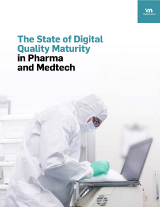
GxP Lifeline
3 Ways Digital Technology Is Improving Medical Device Risk Management

Medical device risk management is a key part of setting and achieving quality goals. Because technology is advancing so quickly, it can be hard for medtech companies to keep up, let alone take advantage of these improvements.
Medtech companies must consider some of the ways digital technology can transform their medical device risk management system. When they embrace digital quality management, they can increase the safety and performance of their medical devices.
Here are three ways digital technology can improve medical device risk management:
1. Regulatory Compliance
The U.S. Food and Drug Administration (FDA) Quality System Regulation outlines the requirements for design control, which aims to protect patients from unnecessary risk. While the range of a design control system depends on the size and structure of a company, the methods of design and development, and methods of medical device risk management, design controls must be in place to market a product in the US.1
The application of design controls, as pictured in the FDA’s waterfall design, is a multi-step process. When done correctly, a lot of data will be generated. Without an experienced staff, a medtech company might struggle to carry out all the necessary steps of design control. How might medical device risk management be improved through digital technology?
With an electronic quality management system (eQMS), many basic regulatory requirements are built in. Users have easy access to the latest versions of design-related documents. Through digital technology, users can track changes, share feedback, and leave comments. The review process is automated as the medical device eQMS assigns tasks to reviewers, sends reminders, and keeps track of the approval process.
Digital quality management improves the discovery of quality problems and provides insight into root causes.2 Through automation, digital quality management enhances regulatory compliance and allows the company to focus on developing and designing medical devices.
2. Connectivity
Medical device risk management is knit into the design control process, and output from each stage becomes design input for the next step.3 As the process continues, requirements, specifications, and verification and validation requirements are developed.
Essential to medical device risk management, these pieces are traditionally linked together in a traceability matrix (TM). The TM maps the various requirements, needs, output, and even regulatory requirements.
Often, the TM is housed in a simple spreadsheet. While spreadsheets are adequate homes for TMs, they are not always perfect. As the project grows, spreadsheets can become clunky. Cross references may not be immediately visible. Risk management software shines in its ability to map the connections between related processes.
Digital quality management systems provide easy access to cross-referenced documents. Instead of searching for and saving multiple copies, important records can be accessed through links. Risk management software improves visibility to relevant data and provides access to current up-to-date records.4
Switching to a risk management software as part of a medical device eQMS ensures real-time, dynamic risk management throughout the quality management system; truly implementing a risk management life cycle.
3. Automatic Data Integrity
Technology has not been without its hiccups in the medical device industry. As technology has advanced, the FDA has kept pace; implementing controls such as 21 CFR Part 11 and the Data Integrity guidance. Due to increasing regulatory scrutiny, medical device risk management must ensure the integrity of all data.
So much of the risk assessment process relies on data. As an interconnected system, human errors, transcription mistakes, and large volumes of data can increase the risk of a data integrity violation. Access controls, metadata, and audit trails amplify the complexity of medical device risk management, which in turn can increase costs that often medtech companies cannot afford.
When medtech companies implement digital quality management, it allows trends and correlations to be easily identified, even within massive datasets.5 With an eQMS, built-in features like version control, audit trails, and access controls ensure the ALCOA (Attributable, Legible, Contemporaneous, Original, and Accurate) principles of data integrity are followed. These digital tools empower medtech companies to comply with regulatory requirements, safeguard data integrity, and minimize the risks associated with manual data management.
Embracing Digital Quality Management
https://www.mastercontrol.com/quality/risk-software/medical/ Medical device risk management is essential for safe and compliant performance. Taking advantage of digital technology through a digital quality management solution enables medtech companies to streamline compliance in their risk management processes, enhance connectivity between different stages of design control, and ensure the integrity of data used throughout the process.
To ensure the successful implementation of risk assessment software or an eQMS, medtech company leadership, especially quality managers, should understand the impact of digital technology on product quality.6 Leaders must also ensure personnel are trained and competent in the use of digital quality management tools.
By leveraging digital quality management tools, medtech companies can strengthen their medical device risk management compliance efforts, improve overall efficiency, and ultimately deliver safer and more reliable medical devices to patients.
References:
- "DESIGN CONTROL GUIDANCE FORFOR MEDICAL DEVICE MANUFACTURERSMEDICAL DEVICE MANUFACTURE," FDA, March 11, 1997. [Accessed May 22, 2023].
- "DIGITAL QUALITY MANAGEMENT SYSTEMS: BENEFITS AND CHALLENGES," R. Ibrahim, Engineering Science, pp. 163-172, 2019.
- Supra note 1.
- Supra note 2.
- Supra note 2.
- "A review of quality 4.0: definitions, features, technologies, applications, and challenges," S. Sader, I. Husti and M. Daroczi, Total Quality Management, 2021.
Free Resource

Enjoying this blog? Learn More.
The State of Digital Quality Maturity in Pharma and Medtech
Download Now